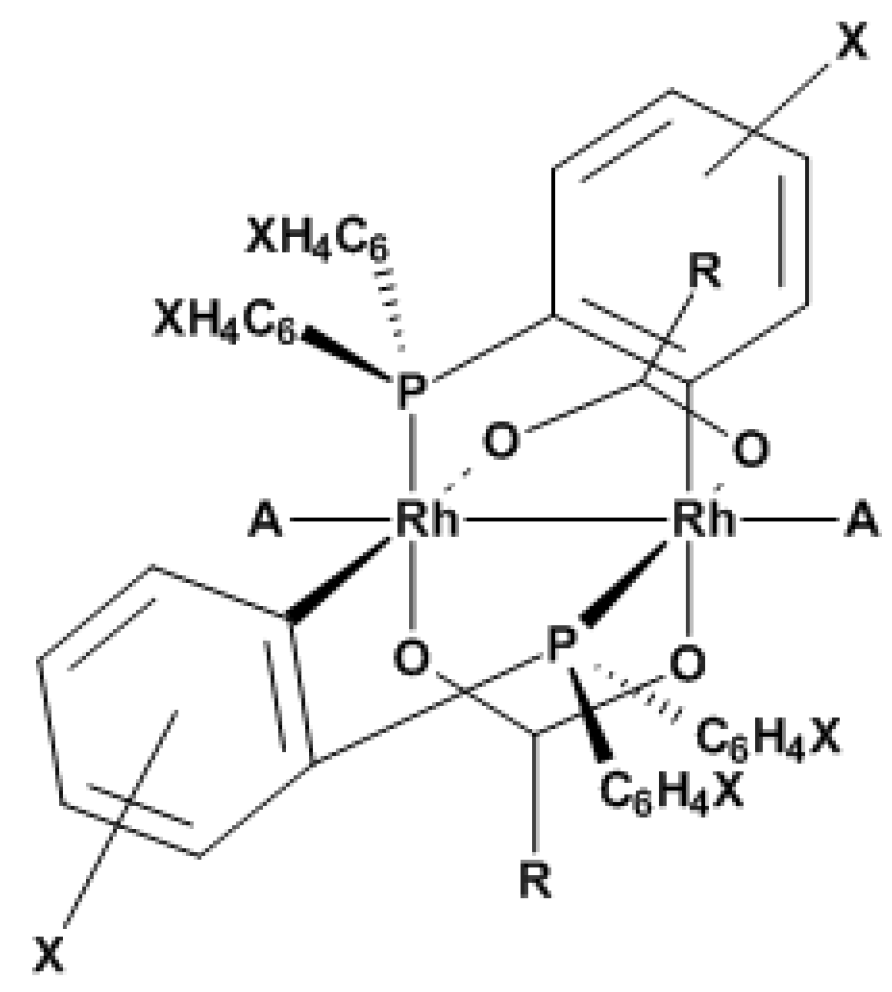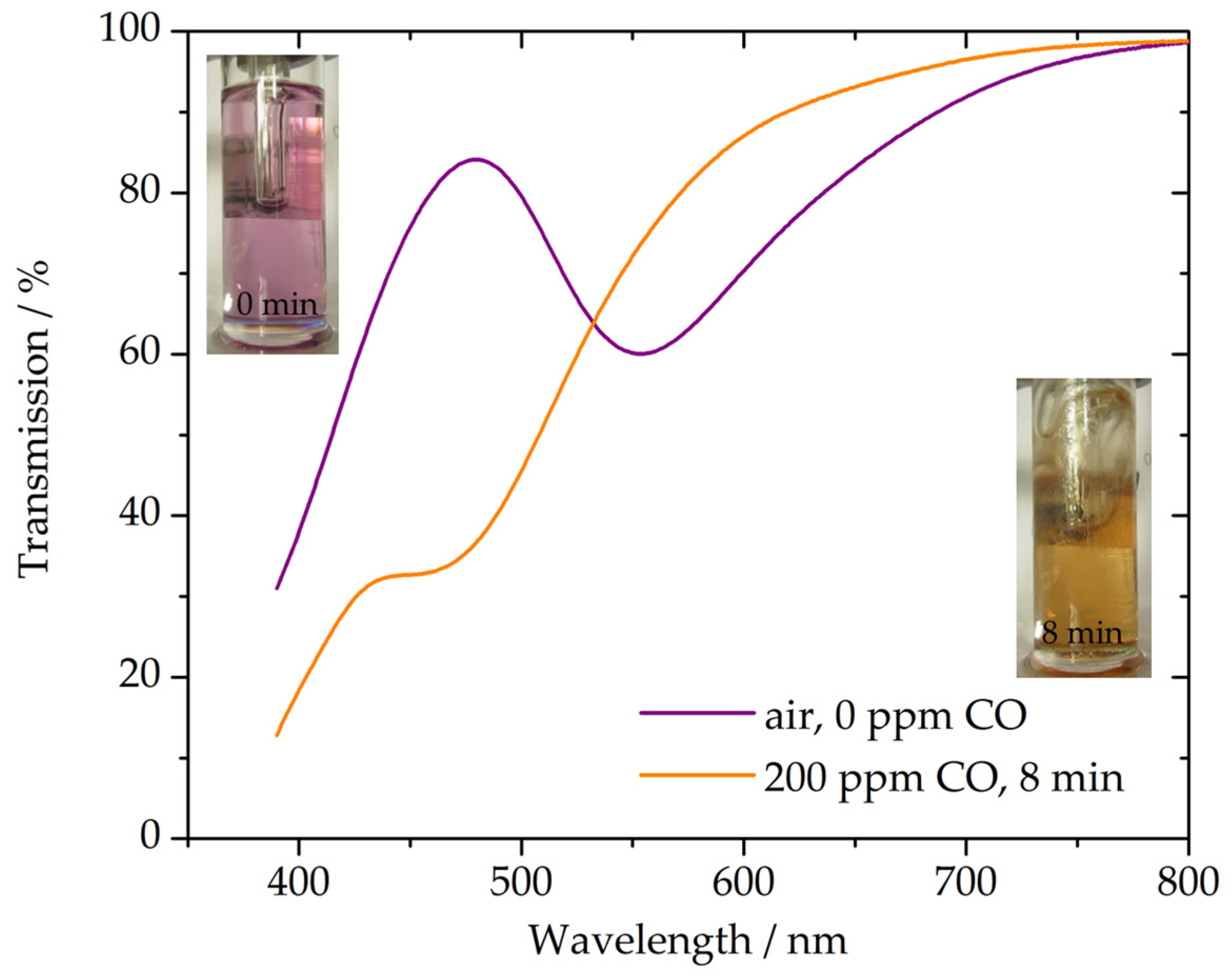Investigation of Gasochromic Rhodium Complexes Regarding Their Reactivity towards CO †
Abstract
1. Introduction
2. Experimental Part
2.1. Synthesis of Binuclear Rhodium Complexes
2.2. Fabrication of the Gas-Sensitive Layers
2.3. Gas Sensing Experiments
3. Results and Discussion
4. Conclusions
Acknowledgments
Conflicts of Interest
References
- Jackson, M.; Robins, I. Gas sensing for fire detection: Measurements of CO, CO2, H2, O2, and smoke density in European standard fire tests. Fire Saf. J. 1994, 22, 181–205. [Google Scholar] [CrossRef]
- Courbat, J.; Pascu, M.; Gutmacher, D.; Briand, D.; Wöllenstein, J.; Hoefer, U.; de Rooij, N.F. A colorimetric CO sensor for fire detection. Procedia Eng. 2011, 25, 1329–1332. [Google Scholar] [CrossRef]
- Martinek, M.J.; Marti, W.C. Modified Iodine-Pentoxide Method for Determination of Carbon Monoxide in Air and Blood. Am. J. Public Health Nations Health 1929, 19, 293–298. [Google Scholar] [CrossRef] [PubMed][Green Version]
- Shepherd, M. Rapid determination of small amounts of carbon monoxide. Anal. Chem. 1947, 19, 77–81. [Google Scholar] [CrossRef]
- Paul, S.; Amalraj, F.; Radhakrishnan, S. CO sensor based on polypyrrole functionalized with iron porphyrin. Synth. Met. 2009, 159, 1019–1023. [Google Scholar] [CrossRef]
- Filippini, D.; Alimelli, A.; di Natale, C.; Paolesse, R.; D’Amico, A.; Lundström, I. Chemical sensing with familiar devices. Angew. Chem. 2006, 118, 3884–3887. [Google Scholar] [CrossRef]
- Esteban, J.; Ros-Lis, J.V.; Martínez-Máñez, R.; Marcos, M.D.; Moragues, M.; Soto, J.; Sancenón, F. Sensitive and selective chromogenic sensing of carbon monoxide by using binuclear rhodium complexes. Angew. Chem. 2010, 49, 4934–4937. [Google Scholar] [CrossRef] [PubMed]
- Moragues, M.E.; Esteban, J.; Ros-Lis, J.V.; Martínez-Máñez, R.; Marcos, M.D.; Martínez, M.; Sancenón, F. Sensitive and selective chromogenic sensing of carbon monoxide via reversible axial CO coordination in binuclear rhodium complexes. J. Am. Chem. Soc. 2011, 133, 15762–15772. [Google Scholar] [CrossRef] [PubMed]
- Moragues, M.E.; Esteban, J.; Ros-Lis, J.V.; Martínez-Máñez, R.; Marcos, M.D.; Martínez, M.; Sancenón, F. An optoelectronic sensing device for CO detection in air based on a binuclear rhodium complex. Sens. Actuators B Chem. 2014, 191, 257–263. [Google Scholar] [CrossRef]
- Pannek, C. Mikrosystem zur Brandgasdetektion nach dem Farbumschlagsprinzip. Dissertation. ISBN: 978-3-86247-516-2.




| Compound | X= | R= | A= |
|---|---|---|---|
| 1∙(A)2 | p-OCH3 | CH3 | CH3CO2H |
| 2∙(A)2 | m-CH3 | CH3 | CH3CO2H |
| 3∙(A)2 | m-F | CH3 | CH3CO2H |
| Solution # | Composition |
|---|---|
| S1 | 5 mg 1∙(A)2 in 1 mL CHCl3 + 5 mL matrix solution (750 mg EC, 750 mL TBP, 30 mL ethanol) |
| S2 | 6 mg 2∙(A)2 in 1 mL toluene + 3 mL matrix solution (750 mg EC, 750 mL TBP, 30 mL toluene) |
| S3 | 6 mg 3∙(A)2 in 1 mL toluene + 3 mL matrix solution (750 mg EC, 750 mL TBP, 30 mL toluene) |
| S4 | 12 mg 1∙(A)2 + 1 mL matrix solution (750 mg EC, 750 mL TBP, 30 mL toluene) |
| S5 | 11 mg 2∙(A)2 + 1 mL matrix solution (750 mg EC, 750 mL TBP, 30 mL toluene) |
| S6 | 11 mg 3∙(A)2 + 1 mL matrix solution (750 mg EC, 750 mL TBP, 30 mL toluene) |
Publisher’s Note: MDPI stays neutral with regard to jurisdictional claims in published maps and institutional affiliations. |
© 2017 by the authors. Licensee MDPI, Basel, Switzerland. This article is an open access article distributed under the terms and conditions of the Creative Commons Attribution (CC BY) license (https://creativecommons.org/licenses/by/4.0/).
Share and Cite
Tarantik, K.; Schmitt, K.; Pannek, C.; Miensopust, L.; Wöllenstein, J. Investigation of Gasochromic Rhodium Complexes Regarding Their Reactivity towards CO. Proceedings 2017, 1, 454. https://doi.org/10.3390/proceedings1040454
Tarantik K, Schmitt K, Pannek C, Miensopust L, Wöllenstein J. Investigation of Gasochromic Rhodium Complexes Regarding Their Reactivity towards CO. Proceedings. 2017; 1(4):454. https://doi.org/10.3390/proceedings1040454
Chicago/Turabian StyleTarantik, Karina, Katrin Schmitt, Carolin Pannek, Lutz Miensopust, and Jürgen Wöllenstein. 2017. "Investigation of Gasochromic Rhodium Complexes Regarding Their Reactivity towards CO" Proceedings 1, no. 4: 454. https://doi.org/10.3390/proceedings1040454
APA StyleTarantik, K., Schmitt, K., Pannek, C., Miensopust, L., & Wöllenstein, J. (2017). Investigation of Gasochromic Rhodium Complexes Regarding Their Reactivity towards CO. Proceedings, 1(4), 454. https://doi.org/10.3390/proceedings1040454





